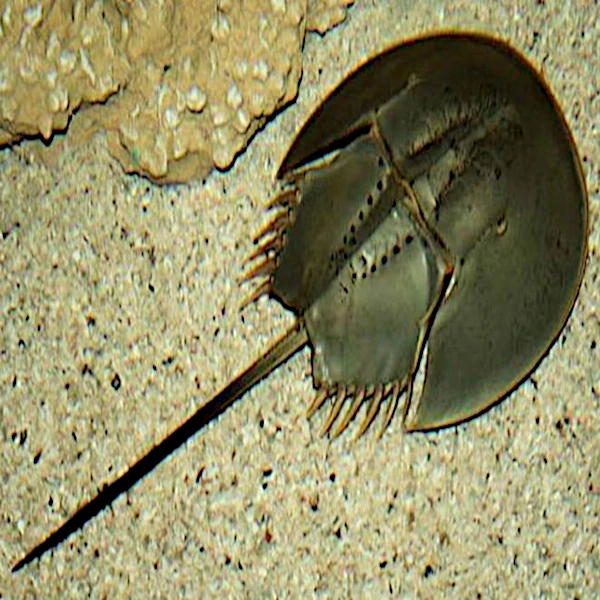
Image: Aquaportail.
The horseshoe crab (Limulus polyphemus) is not a true crab, but rather a distant relative of spiders and scorpions.
The horseshoe crab is a fascinating creature and incredibly equipped for survival. It is considered a living fossil.
The horseshoe crab species has been around since the Devonian (around 450 million years ago), an incredibly long time for a species on Earth. The average lifespan of an animal species before it becomes extinct is approximately 2.8 million years. This estimate is based on a 2015 study that examined the lifespans of 12,000 animal species.
The horseshoe crab's anatomical features are unique and have allowed it to adapt to millions of years of environmental evolution. Horseshoe crabs have evolved little over time and are very similar to life forms that existed hundreds of millions of years ago.
This species has survived several mass extinctions, and its evolutionary history is exceptionally long.
There have been five major mass extinctions during Earth's history. At the end of the Ordovician, about 443 million years ago, at the end of the Permian, about 252 million years ago, at the end of the Triassic, about 201 million years ago and at the end of the Cretaceous, about 66 million years ago.
Horseshoe crabs have withstood extreme environmental conditions, and they are still present today.
Horseshoe crabs have survived brutal climate changes, glaciations, massive volcanic eruptions in the marine environment, variations in water oxygen levels, significant changes in the chemical composition of the oceans, numerous predatory pressures, etc.
Horseshoe crabs have two large compound eyes, meaning each eye is made up of many small, independent visual elements called ommatidia. Each ommatidia acts as an autonomous visual unit, sensitive to different light intensities and different polarizations of light. Due to the arrangement of ommatidia, horseshoe crabs' eyes provide extensive panoramic vision in order to detect prey and predators.
The horseshoe crab has effective protection. Its rigid and robust horseshoe-shaped shell allows it, despite everything, great mobility, essential for locomotion. This rigidity is attributed to the presence of chitin, a polysaccharide present in the exoskeleton of arthropods.
The horseshoe crab's five pairs of appendages are protected by a sturdy exoskeleton, providing a durable structure for the tasks of scavenging, prey capture, food handling, and movement.
Unlike many other arthropods, the horseshoe crab uses hemocyanin as the respiratory pigment in its blood rather than hemoglobin. Unlike hemoglobin found in vertebrates, which gives a red tint to blood, hemocyanin gives a blue color when oxygenated. Hemocyanin is associated with adaptability to varying environmental conditions, such as fluctuating oxygen levels. Additionally, organisms that use hemocyanin often have an open circulatory system. This type of system allows blood, which carries hemocyanin, to flow directly through body cavities, irrigating tissues without being confined in closed blood vessels, as is the case in a closed circulatory system.
Horseshoe crabs perform external fertilization. Females lay thousands of eggs in a single clutch on the sand during high tide. These eggs have a characteristic green color and are arranged in a gelatinous mass that adheres to the seafloor. Horseshoe crab reproduction is associated with impressive mass migrations to nesting areas. Larvae hatch from eggs and go through several stages before becoming juveniles. The larvae have an excellent ability to feed, swim and avoid predators, which contributes to their survival during the first stages of their life.
Horseshoe crabs have a relatively well-developed brain located in their prosoma (anterior part). In addition to the brain, they have several nerve ganglia distributed along their length. ventral nerve chain. These ganglia play a role in processing sensory information and controlling movements. Horseshoe crabs are known for their rapid behavioral responses, including their ability to react quickly to stimuli such as light and vibration. These rapid responses are important for predator avoidance and mate finding.
The age of this species is truly remarkable, dating back to a time when many current life forms had not yet evolved.
The ability of horseshoe crabs to survive these varied and often extreme environmental conditions demonstrates their evolutionary resilience and successful adaptation to diverse environments over time.
We see that all these living species are adapted to their environment, that they develop, reproduce and disappear after 2 million years, but the horseshoe crab is still present today, as a living link with the past of Earth.